
In Episode 47 of the Cartel Conversations Podcast, the hosts, Ian Holmes and Tom Conboy, introduced the 2024 Micro Model Railway Cartel Challenge. For 2024 the challenge is to build a shoebox layout. For those who are in the dark, the late Carl Arendt featured this type of layout in several articles (links below).
- Layouts in Boxes – includes original article of Carl’s Imports
- Shoebox Madness – Three for the show
- Shoebox Madness – In Other Works
- Shoebox Madness – New Designs
Since the announcement of the challenge, I have been looking at various layout styles and subjects for the challenge. When planning a new layout, even a micro, its always best to make a list of considerations for a design. This helps ensure the pit falls of the layout are known and make it more likely to see the project through to completion.
In this article, I will explore some of the possibilities along with the positives and negatives of each. Many of the considerations are specific to me, taking into consideration, available locos, structures, and other design elements. Some of these considerations include time. The challenge ends on November 30, 2024, so whatever I do it must be completed by then. Complex builds are off the table.
One very big consideration is “Show Display Strength”. What I mean by that is the layout’s ability (or strength) to hold a viewer’s attention while on display at a show/exhibition. If there is not constant movement (i.e. trains running), many viewers will lose interest very quickly. For shunting layouts this becomes a problem. A shunting layout will require constant work to keep the animation of the layout in motion and hold attention. As soon as you engage with a viewer and stop shunting, other visitors to your layout quickly loose interest. There are various ways to counteract this but that is a subject for a future article. In this article we will simply look at the train shunting/continuous running as the level of Show Display Strength.
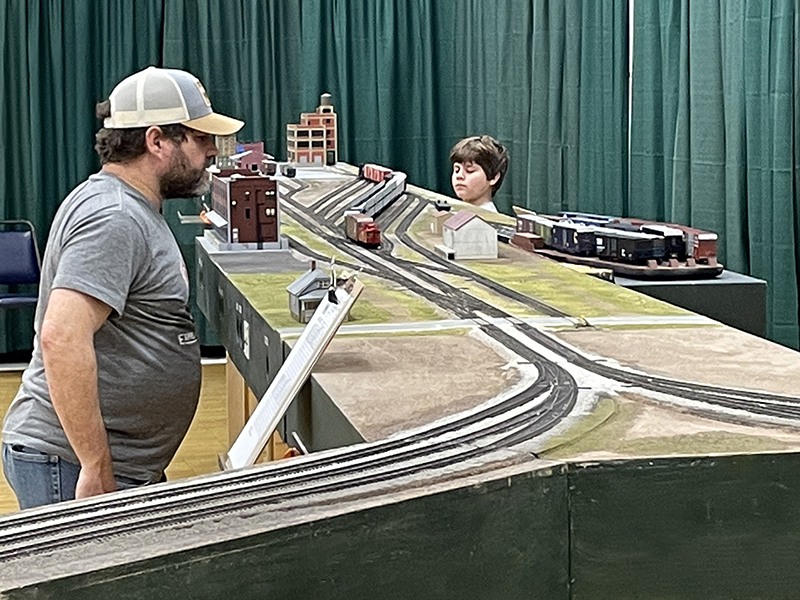
While exhibiting my Boat Yard module set, I found it very difficult to talk to viewers an operate trains at the same time. Luckily, I recruited this father/son team to run trains while I talked with the various spectators.
Now shoeboxes come in many shapes and sizes. The 2024 Micro Model Railway Cartel Challenge has not put many restrictions on the box size as long as footwear (shoes or boots) came in the original box. For this article we are going to use a Skechers shoe box I happen to have available which is 9.5in x 13.5in (approximately 241mm x 343mm).
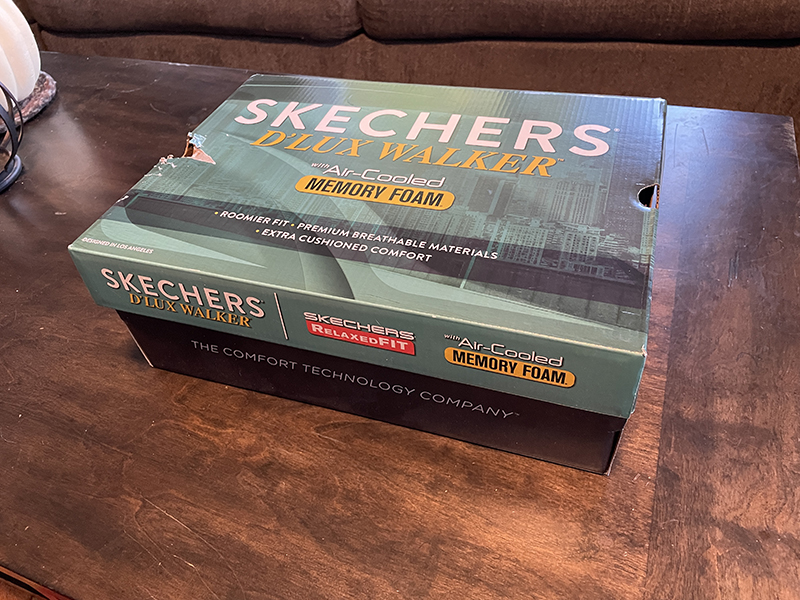
Another design aspect to consider is that the rules state all components of the layout (minus rolling stock and power) must fit into the box but may “unfold” or assemble into a different shape once removed from the box. This means that the layout could be much bigger than the shoebox listed above but then it will be limited in other ways like building height (if components are stacked) or width if creating a folding layout. For the designs we will explore here, I am going to stick with the base size of the box. Extra room will only be allowed for storing a fiddle track if required.
Engine Service Facility
This type of layout always makes every layout idea list I create, but I have yet to attempt the subject. If you have multiple locomotives which sit in their box most of the time and you want to show them off, this plan is a great option. Trains are short with single engines doing most of the prototype movements. If the spaces allows it, some extra tracks for fuel, sand, and equipment can be added which also adds some additional prototype movements.
At only 13.5in long, this will only be a series of tracks mostly in parallel. At most only one turnout will fit and still allow room either side for movement. A locomotive shed would just be a false front and the background could include the walls of a back shop.
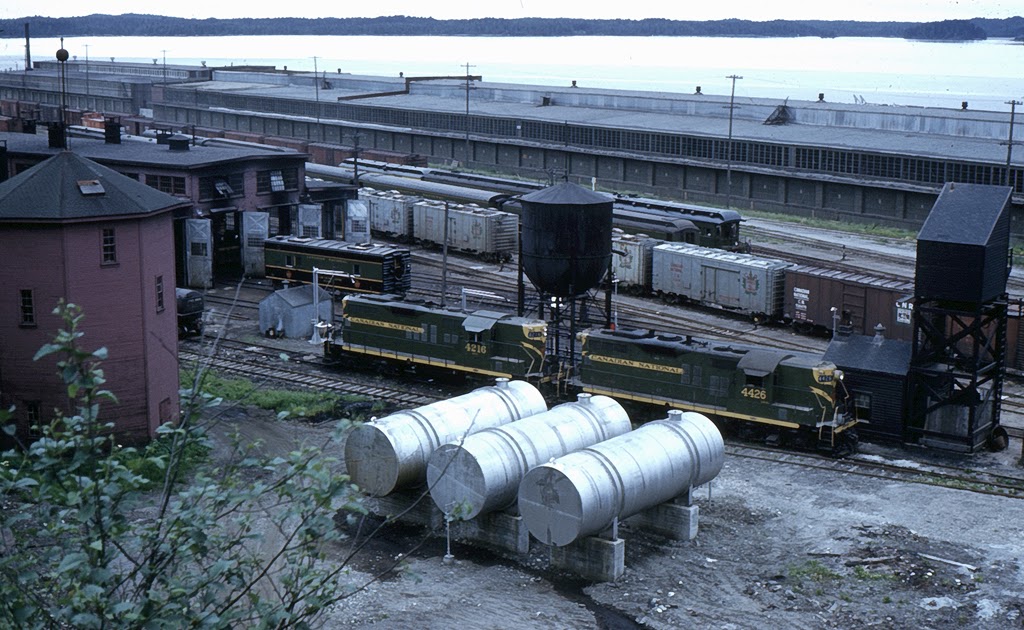
The above image provides a good visual of what a service facility might look like with an engine shed, a few tracks and a background of buildings.
Positives
- Prototype operations
- Shortest trains for small space
- Has show appeal for the modeler
- Great for those who want to just display models
Negatives
- Display Strength can be low as it is shunting only
- Building types are specific (placing a farm house here would be out of place) which limits options and will require me to build new models.
- Requires a higher number of turnouts
Interurban/Trolly – Continuous Running
Turning a train around in a 9.5 inch space is near impossible in most scales. For an interurban or trolly this is not the case. Even the prototype has to make it around very tight curves. Using a Kato 11-109 mechanism, I know I can go all the way down to a 3in radius. With the addition of some city buildings and streets you have an urban scene with continuous running.
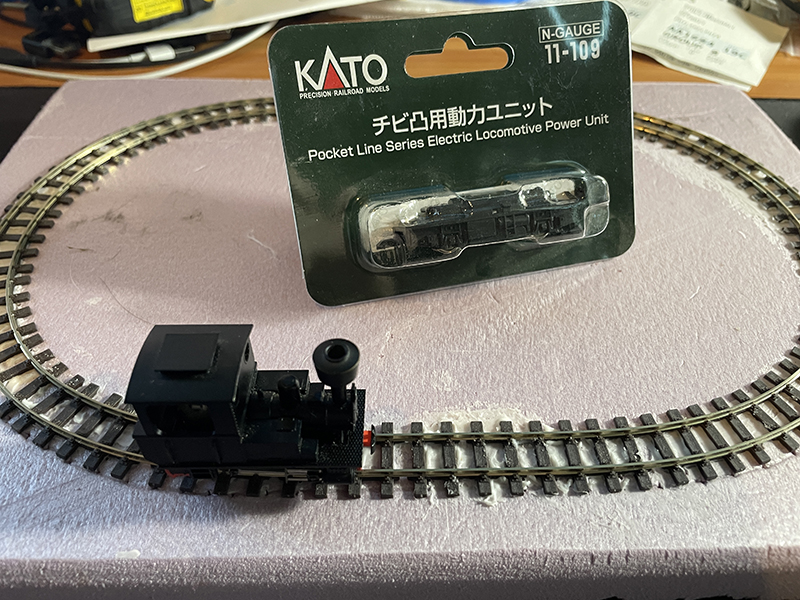
This base was created for another project but is the right size for an interurban loop with just a 3in radius. The Kato 11-109 and the Minitrains Koppel will both negotiate the tight track circle.
Positives
- Show Display Strength is strong
- Has show appeal for the modeler with the ability to have lots of little scenes
- Can use on-hand buildings as interurbans when everywhere
- Very simple layout design does not require turnouts
Negatives
- I don’t have any small scale trolly equipment so investment is required
- No operations as it just goes round and round
- Limited on what can run on the layout due to sharp curves
Interurban/Trolly – Point-to-Point Auto Reversing
A loop is not the only option for an interurban layout since interurban equipment is designed to travel in either direction. By setting up an automated reversing circuit, the equipment could traverse the layout on a schedule and even include a timed stop if desired.

The Circuitron 800-5401 HO AR-2 Automatic Point-to-Point Reversing Circuit for DC layouts is a great choice for an automated system that will keep viewers happy. It includes an adjustable delay to hold train at sensor before reversing
Positives
- Show Display Strength is strong
- Has show appeal for the modeler with the ability to have lots of little scenes
- Can use on-hand buildings as interurbans when everywhere
- Operations are possible when automated circuit is turned off
Negatives
- Again, small scale trolly equipment investment is required
- Requires setup/design/purchase of auto-reverser
Mining
I like narrow gauge equipment in HOn30/OO9 and On18/O9 and mining operations used similar 30in and 24in gauges a lot! I also have equipment and buildings from other defunct layouts which are available to use. It would seem like this should be a no-brainer but I struggle with the layout plan. I like things to have purpose and the track arrangement causes me issues every time. This would also be a shunter, so keeping the crowd entertained will be an issue. I am not a fan of auto-reverse when it involves anything more than just motive power like an interurban.
My vision for a mining layout would either be short trains in and around a mine entrance doing shunting or a tipple being loaded from above into a standard gauge car below. For the shunter, we would use a fiddle track and align it to the few tracks as needed. For the tipple scene I would use a full scale hopper or gondola and have the train above be animated. The train would disappear into a tunnel or into the woods which would hide the fiddle track.
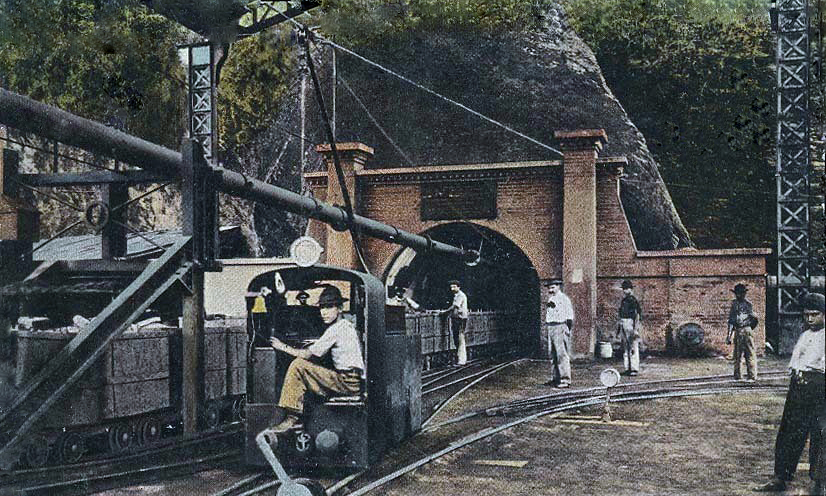
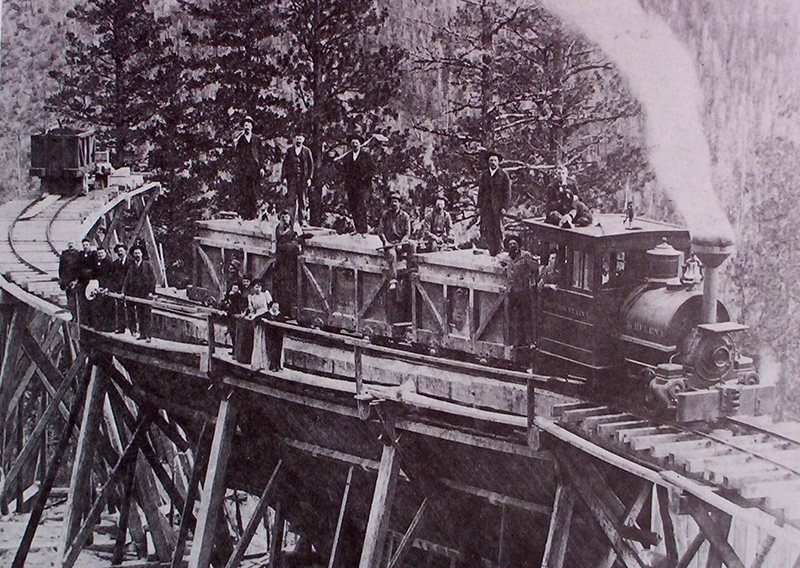
The images above show prototype images that would be inspiration for the mining layout. both used tiny locomotives to move the materials.
Positives
- Have the motive power and the rolling stock
- Have several buildings and accessories
- Operations are possible with shunting
Negatives
- Display Strength can be low as it is shunting only
- Requires a higher number of turnouts
- Personal satisfaction with operations/track plan
Logging
Just like the Mining scenario above, logging companies did use narrow gauge. Even better, they were “cheap” and used anything they could to get the job done. As a result, any equipment I have goes in this scenario. While some find scenery difficult, I find natural scenery to be easy. Mother nature is messy, and colors vary far and wide as long as you do not get wild. This suits me well as creating scatter and stuff is just a matter of throwing it down and add glue. Believe me, I do use some basic rules, like no long grass under trees and the colors need to represent the season but I find once you start layering it all just blends together.
With the limited area, the scene would be set to a single subject like the camp, the mill, or where trees are being harvested. Mini scenes and nature would fill the rest. Buildings could be built quick with bare wood as everything in logging is temporary till the trees are harvested.
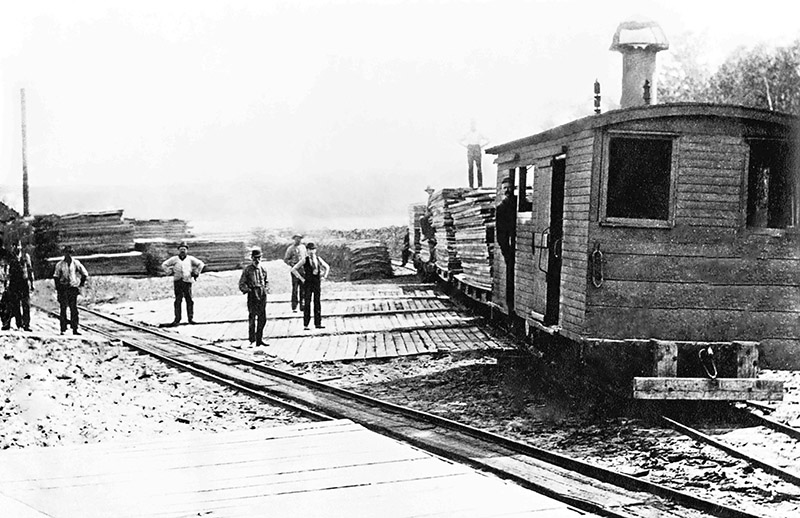
This image typifies the logging industry with a home made locomotive being used at the mill for moving rough sawn lumber around the complex. Keep in mind that after logs have been sawn, the lumber is not ready for sale. It must go through a drying process which means stacking and restacking until the lumber is thoroughly dry. Small locomotives and tramways were used around the sawmill yards for moving materials.
Positives
- I have some logging equipment
- Trees/nature can hide a lot and create vignettes for scenes
- Structures can be raw and unfinished
Negatives
- Display Strength can be low as it is shunting only
- Although simple in design, I will have to build structures
WWI Artillery Battery
You may be wondering why this is so specific. It’s because I have the railroad equipment and the components to create the WWI battery scene in HO scale (using HOn30/OO9 trains). The scenery and the figures are the hard part. Being a war model, this will be highly critiqued by the military modeler community and I would strive to get things as accurate as I could. I would like to do an American scene, but may be forced to do a British scene because of the lack of WWI American figures.
An automated shunting circuit would be an option for this as WWI trains frequently were not turned and pushed as much as they pulled. We just have to make the track perfect while making it look unkept and in a war zone. The WWI scenario would also allow the train to disappear behind a wall, into a building or into a trench. Only to return a few minutes later, entertaining the audience. I would also try to add lights and sounds to give the scene a war zone ambiance.
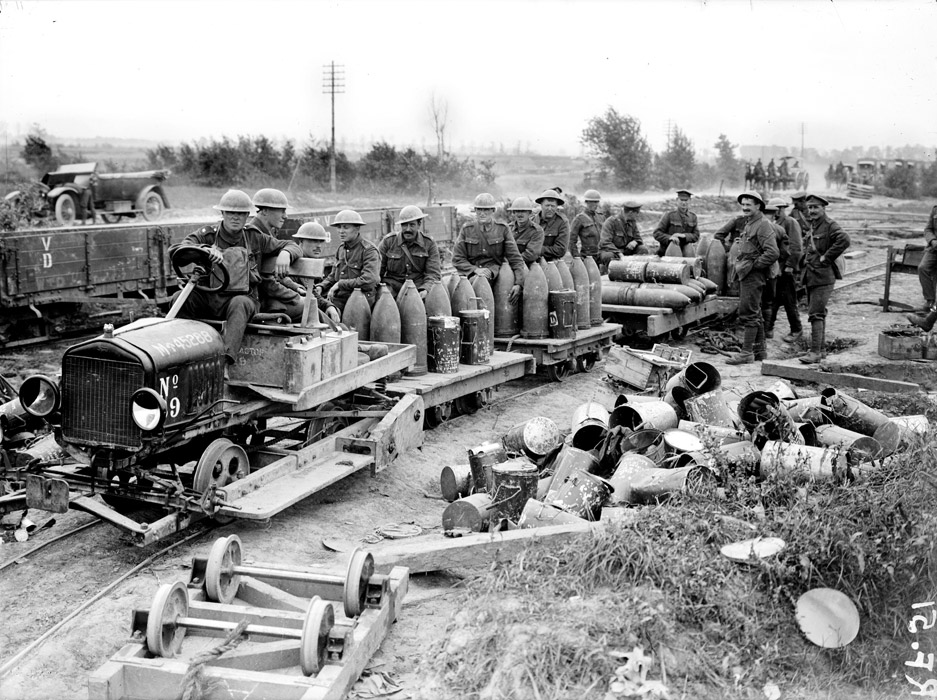
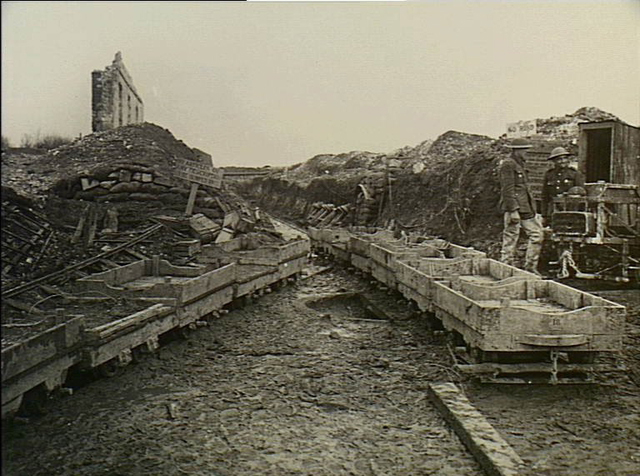
The above photos show examples of trench railroads during WWI. As can be seen in the first photo, the soldiers would use anything available to get materials where they needed to go. This location must be next to an artillery emplacement due to the number of spent shells in close proximity and the fresh shells being delivered. The next photo shows how the rails would be hidden from enemy view in ditches/trenches dug for that purpose.
Positives
- I have most of the equipment
- Display Strength would be high with auto-shunting and war zone lights and sounds
- No buildings unless I choose to hide the train in one
Negatives
- Scenery is a little harder as I want it accurate and hiding the ground with grass is not an option
- WWI figures in 1:87 and 1:76 scale is hard to acquire
- War zone effects requires extra work and electronics
Conclusion
So there you have it, my top list of possible layouts to fit in a shoebox. I must admit, I am very late starting this challenge and I most likely will not finish in time. It has been a very busy summer and my hobby time has been very limited. Just look at how many articles I have done this year (sigh).
All of these layout ideas have been thought of before. Many have appeared on this blog in other forms but to date none have been completed to a state I would call them finished. I do have a habit of over extending myself. The shoebox layout limits the size and can serve as a testbed for the idea. It allows for the experimentation of some of these ideas without too big of an investment. In this respect, even if I do not finish the layout for the contest, it will still serve a function and give me some additional experience with the scenario I choose. If all goes well, I am sure there will be another post here to show the results.
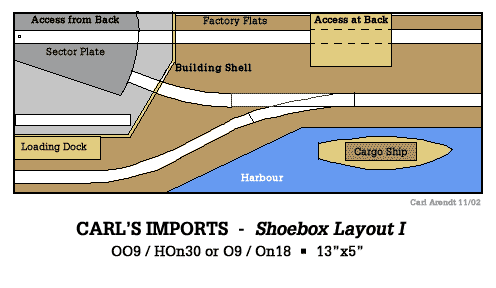
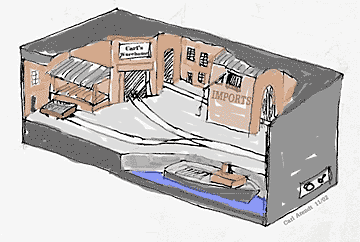
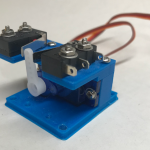
For WWI figures, google 20mm Great War or WWI military miniatures. There’s been scale creep over the years (figures getting larger and larger) so even 15mm figures might work. I had Battlefront WWI 15mm minis and they worked well with the Minitrains trench railway series.
Appreciate the information. I am out shopping now!!